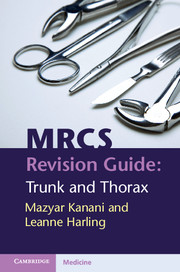Book contents
- Frontmatter
- Contents
- Preface
- Section 1 Clinical surgery in general
- Section 2 Thorax
- Section 3 Trunk
- Chapter 7 Applied surgical anatomy
- Chapter 8 Applied surgical physiology
- Chapter 9 The abdominal wall
- Chapter 10 The abdominal aorta and abdominal aortic aneurysms
- Chapter 11 The oesophagus, stomach and small bowel
- Chapter 12 The liver, biliary tree and pancreas
- Chapter 13 The spleen: splenic trauma and splenectomy
- Chapter 14 The large bowel
- Chapter 15 The rectum and anus
- Chapter 16 The kidneys and genitourinary system
- Bibliography
- Index
Chapter 12 - The liver, biliary tree and pancreas
Published online by Cambridge University Press: 05 February 2012
- Frontmatter
- Contents
- Preface
- Section 1 Clinical surgery in general
- Section 2 Thorax
- Section 3 Trunk
- Chapter 7 Applied surgical anatomy
- Chapter 8 Applied surgical physiology
- Chapter 9 The abdominal wall
- Chapter 10 The abdominal aorta and abdominal aortic aneurysms
- Chapter 11 The oesophagus, stomach and small bowel
- Chapter 12 The liver, biliary tree and pancreas
- Chapter 13 The spleen: splenic trauma and splenectomy
- Chapter 14 The large bowel
- Chapter 15 The rectum and anus
- Chapter 16 The kidneys and genitourinary system
- Bibliography
- Index
Summary
Gallstones
Briefly explain the processes involved in the formation and excretion of bilirubin
Bilirubin is produced in the spleen and reticuloendothelial system as the terminal product of haem catabolism. Unconjugated bilirubin is transported from the spleen in the blood bound to plasma albumin. In the liver, bilirubin is released from albumin and taken up by hepatocytes where conjugation (glucuronidation) occurs by the action of UDP glucuronyl transferase. Bilirubin is then released into the gut where deconjugation and conversion to urobilinogen occurs by the action of gut bacteria. Urobilinogen (water-soluble) is partially reabsorbed by the gut into the portal system (enterohepatic circulation), whilst the remainder is oxidized in the colon to produce stercobilinogen, the brown faecal pigment. Traces of urobilinogen reach the systemic circulation and are excreted in the urine.
List the commonest types of gallstones
Cholesterol stones (~80%) - These are often formed as large, solitary gallstones and are made up of cholesterol monohydrate crystals. These form when the cholesterol concentration of bile exceeds the ability of bile salts to dissolve cholesterol and lectin. This may occur either as a result of supersaturation of the bile with cholesterol or as a result of bile salt deficiency.
- Type
- Chapter
- Information
- MRCS Revision Guide: Trunk and Thorax , pp. 91 - 105Publisher: Cambridge University PressPrint publication year: 2012



